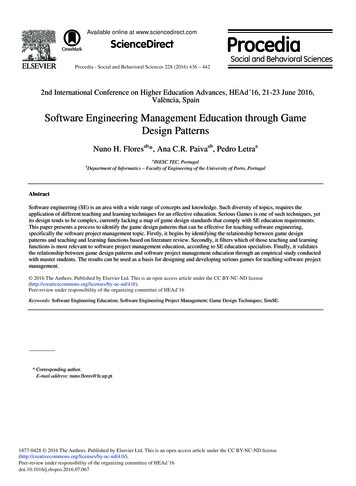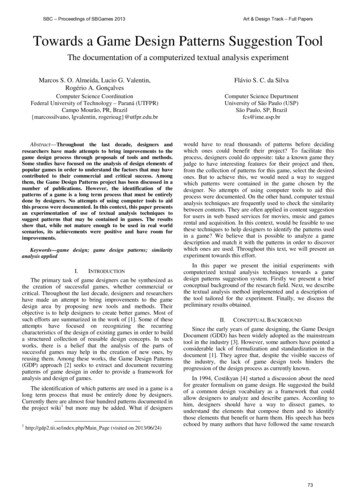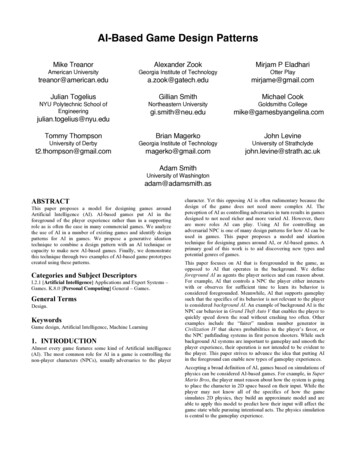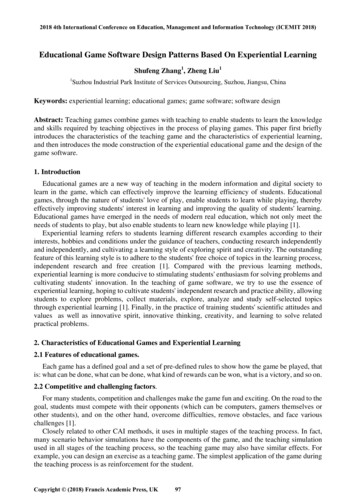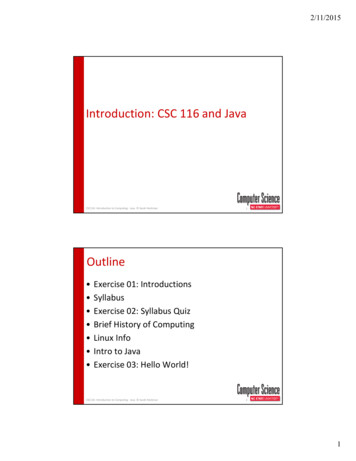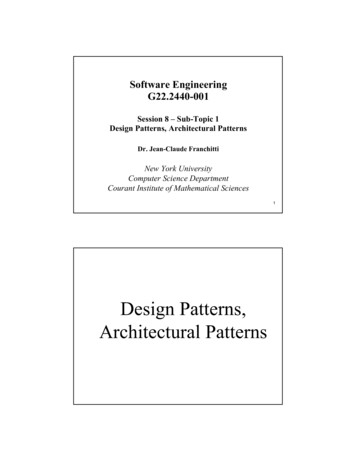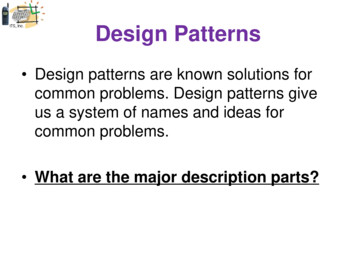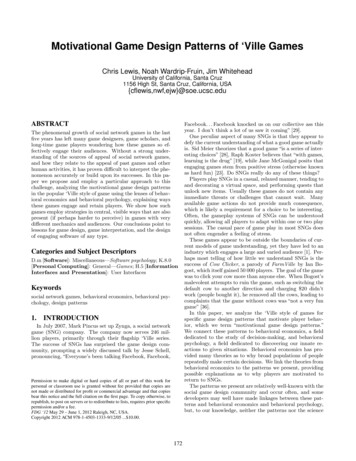
Transcription
Motivational Game Design Patterns of ‘Ville GamesChris Lewis, Noah Wardrip-Fruin, Jim WhiteheadUniversity of California, Santa Cruz1156 High St, Santa Cruz, California, USA{cflewis,nwf,ejw}@soe.ucsc.eduABSTRACTThe phenomenal growth of social network games in the lastfive years has left many game designers, game scholars, andlong-time game players wondering how these games so effectively engage their audiences. Without a strong understanding of the sources of appeal of social network games,and how they relate to the appeal of past games and otherhuman activities, it has proven difficult to interpret the phenomenon accurately or build upon its successes. In this paper we propose and employ a particular approach to thischallenge, analyzing the motivational game design patternsin the popular ‘Ville style of game using the lenses of behavioral economics and behavioral psychology, explaining waysthese games engage and retain players. We show how suchgames employ strategies in central, visible ways that are alsopresent (if perhaps harder to perceive) in games with verydifferent mechanics and audiences. Our conclusions point tolessons for game design, game interpretation, and the designof engaging software of any type.Categories and Subject DescriptorsD.m [Software]: Miscellaneous—Software psychology; K.8.0[Personal Computing]: General—Games; H.5 [InformationInterfaces and Presentation]: User InterfacesKeywordssocial network games, behavioral economics, behavioral psychology, design patterns1.INTRODUCTIONIn July 2007, Mark Pincus set up Zynga, a social networkgame (SNG) company. The company now serves 246 million players, primarily through their flagship ‘Ville series.The success of SNGs has surprised the game design community, prompting a widely discussed talk by Jesse Schell,pronouncing, “Everyone’s been talking Facebook, Facebook,Permission to make digital or hard copies of all or part of this work forpersonal or classroom use is granted without fee provided that copies arenot made or distributed for profit or commercial advantage and that copiesbear this notice and the full citation on the first page. To copy otherwise, torepublish, to post on servers or to redistribute to lists, requires prior specificpermission and/or a fee.FDG ‘12 May 29 – June 1, 2012 Raleigh, NC, USA.Copyright 2012 ACM 978-1-4503-1333-9/12/05 . 10.00.172Facebook. . . Facebook knocked us on our collective ass thisyear. I don’t think a lot of us saw it coming” [29].One peculiar aspect of many SNGs is that they appear todefy the current understanding of what a good game actuallyis. Sid Meier theorizes that a good game “is a series of interesting choices” [28], Raph Koster believes that “with games,learning is the drug” [19], while Jane McGonigal posits thatengaging games stem from positive stress (otherwise knownas hard fun) [23]. Do SNGs really do any of these things?Players play SNGs in a casual, relaxed manner, tending toand decorating a virtual space, and performing quests thatunlock new items. Usually these games do not contain anyimmediate threats or challenges that cannot wait. Manyavailable game actions do not provide much consequence,which is likely a requirement for a choice to be interesting.Often, the gameplay systems of SNGs can be understoodquickly, allowing all players to adapt within one or two playsessions. The casual pace of game play in most SNGs doesnot often engender a feeling of stress.These games appear to be outside the boundaries of current models of game understanding, yet they have led to anindustry which engages a large and varied audience [1]. Perhaps most telling of how little we understand SNGs is thesuccess of Cow Clicker, a parody of FarmVille by Ian Bogost, which itself gained 50 000 players. The goal of the gamewas to click your cow more than anyone else. When Bogost’smalevolent attempts to ruin the game, such as switching thedefault cow to another direction and charging 20 didn’twork (people bought it), he removed all the cows, leading tocomplaints that the game without cows was “not a very fungame” [36].In this paper, we analyze the ‘Ville style of games forspecific game design patterns that motivate player behavior, which we term “motivational game design patterns.”We connect these patterns to behavioral economics, a fielddedicated to the study of decision-making, and behavioralpsychology, a field dedicated to discovering our innate reactions to given situations. Behavioral economics has provided many theories as to why broad populations of peoplerepeatedly make certain decisions. We link the theories frombehavioral economics to the patterns we present, providingpossible explanations as to why players are motivated toreturn to SNGs.The patterns we present are relatively well-known with thesocial game design community and occur often, and somedevelopers may well have made linkages between these patterns and behavioral economics and behavioral psychology,but, to our knowledge, neither the patterns nor the science
behind them have been throughly documented.We limit our analysis to ‘Ville games because, as Wohnet al. note, “what constitutes a SNG is determined more bythe technical aspects of how it is accessed and distributed,not on the genre of game” [37]. We chose to study ‘Villegames based on their continued popularity, with Zynga easily commanding the most players at the time of writing1 .To evaluate our approach, we attempt to use our framework to provide an explanation of Cow Clicker ’s popularity.The bare-bones design, removing any other game design elements that may have accidentally led to the game beingenjoyable, provides a strong test subject for our framework.2.causing their desire to rise and the process of striving tobegin again [8]. The baseline return is usually explained bypeople’s happiness being relative to the others around them.For example, a graduate student spends all her time dreaming about her first tenure-track job, and she feels a peak ofhappiness when she finally secures it. However, our new professor now moves in social circles where all her friends havetenure, leaving her feeling like she’s not doing as well as herfriends, causing her happiness to return to the baseline.2.2.5BACKGROUND THEORY2.1OverviewThroughout this paper, we will use a number of differenttheories from behavioral economics and behavioral psychology, some of which appear in multiple design patterns. Inthis section, we will define these theories, so that readerscan easily refer back to them.2.22.2.6Behavioral Economics2.2.7Anchoring2.32.3.1Contrast effect2.3.2OverviewGoal-gradient HypothesisGoal-gradient hypothesis is the finding that as animalsapproach a reward, they expend more effort. This behaviorleads to some interesting consequences. For example, peoplein a café reward program purchase more coffees they closerthey are to getting their free reward coffee [18]. In games,progress bars encourage the same behavior [14].Endowment progress effectThe endowment progress effect builds upon the findings ofgoal-gradient hypothesis (described later in 2.3.2), showingthat simply the illusion of progress is enough to induce accelerated behavior; so if a 12-stamp coffee card is given withthe first two marked off for free, customers purchase the final10 coffees quicker than if a 10-stamp card is used [18, 24].Hamari theorizes World of Warcraft’s ‘rested’ bonus createsthis effect [12].2.2.4Behavioral PsychologyBehavioral psychology is a branch of psychology investigated in the early part of the 20th century, which analyzedthe observable behaviors of people and animals, and led tovarious theories such as operant conditioning, where an organism alters its voluntary behavior due to some stimulus.The contrast effect describes how people have a tendencyto perceive things relativistically [35]. We can see this ingames often: a starting car feels moderately powerful in adriving game, but once you’re used to the supercars, thestarting feels much slower than it did before.2.2.3Sunk cost fallacySunk costs are costs which have been incurred and can’tbe recovered, such as buying a membership to a tennis club.The member injures his arm, so shouldn’t continue attending, but exclaims “I don’t want to waste my membershipfee!” and continues to play, hurting his arm further. Thissmall example shows how people are influenced by sunk costs(likely due to loss aversion), and will act irrationally whenfaced with them [33].In the absence of knowing what something is worth, wewill be accept the first price we see as being the baseline.This is known as anchoring: we become anchored to thatprice [4]. All our judgments of value are then based onwhether something appears relatively cheaper or more expensive.2.2.2Reciprocal altruismReciprocal altruism observes that, even if one were to ignore possible motivations for altruism itself (detailed in [34]),people will often respond to an action in kind: altruism withaltruism, hostility with hostility and so on [5].Behavioral economics is a field which utilizes cognitivepsychology to analyze peoples’ decision-making, and takesparticular interest in anomalies from the standard economicmodel, where people do not act “rationally” (i.e. a personmakes some decision which does not lead to a maximum gainfor herself) [22].2.2.1Loss aversionLoss aversion is the observation that people are more upsetby loss than they are made happy by gain. As an example,someone who is given 100 will gain less satisfaction thansomeone else who has 100 taken away from them will lose[17].2.3.3Schedules of ReinforcementSchedules of reinforcement are theories pertaining to howorganisms react when a reinforcer is given after differentperiods. A reinforcer is an event that occurs in responseto some action, and they can either be positive, such as agiving a food pellet, or negative, such as a loud noise. Anumber of schedules are detailed in [9], and here we presentthe ones we will use.Hedonic treadmillThe hedonic treadmill reflects the process of continuallystriving towards a goal that a person anticipates will makethem happy, but then their happiness returns to a baseline,Fixed interval schedule A fixed interval schedule is onewhere the reinforcement is given after a period of timefrom the original response, regardless of what happensin between that time. An example of this is in Animal1According to Appdata.com, Zynga had 246 million monthlyusers, with Electronic Arts and Playdom commanding 49million and 20 million monthly users respectively.173
Crossing, where a player can plant an apple, wait a setamount of time, and then an apple tree will appear.This type of schedule is not particularly effective atincreasing responses.in a social game causes people to return to the game (whichwe also note in this paper), as well as finding usages of techniques such as the endowment progress effect. In a separatearticle, Hamari and Järvinen look at how game mechanicsin SNGs can be used for virality, retention and monetization[13].Avoidance fixed interval schedule This is a modification of the fixed interval schedule, where somethingnegative happens after a fixed period of time unless aresponse takes place. This schedule leads to a slow,steady response to prevent something negative fromoccurring. Hopson previously saw these schedules inUltima Online, where housing would degrade if players did not visit it regularly [14].ShapingShaping is a process that uses rewards to train animalsto perform more complex behaviors, and is commonly seenin training animals (such as giving a dog a treat when itsits down, then only giving the dog a treat when it sits andthen lies down, then only giving the dog a treat when it sits,then lies down, then rolls over. . . ) [30]. Shaping is a coreelement of operant conditioning. For more on this, Yee looksat shaping in Everquest [38].3.3.1PATTERNS4.1OverviewWe studied various ‘Ville games in detail: FarmVille, Pioneer Trail (renamed from FrontierVille), Empires & Allies,Indiana Jones Adventure World (which we’ll refer to as Adventure World for short), CityVille and CastleVille. Weclassify these as ‘Ville games due to their gameplay similarity to FarmVille, where players construct game worlds eitheras a means of attaining more resources or as a creative expression, much like games such as Sim City, The Sims, Harvest Moon and Animal Crossing. A number of other SNGscould also fit inside this categorization, such as The SimsSocial, however we limit our discussion to the Zynga gamesfor consistency.Inside these games we look for what we have termed “motivational game design patterns.” Design patterns were firstsuggested by Alexander [2] as a means of identifying common problems and their solutions. Björk and Holopainendefines game design patterns as “commonly recurring partsof the design of a game that concern gameplay” [7]. Thisexpands the original Alexander usage from just problemsolution pairs to include patterns that are less precise orthat support creative experimentation. We alter Björk andHolopainen’s definition slightly to create motivational gamedesign patterns, which we define as commonly recurringparts of the design of a game that motivate some behavior ina player. For example, the neighbor bar (described in 4.5.3)motivates competitive players to improve their play space.However, we do not include patterns that facilitate reaching the motivated goal. Improving play spaces is facilitatedby the ability to place buildings and decorations. We analyze how the neighbor bar pattern creates this motivation,but disregard the buildings and decorations from our study.We identified four main categories of patterns. Game spacepatterns relate to the virtual world in which the game takesplace; progression patterns reflect how a player progresses inthe game; reward patterns deal with how player actions arerewarded and social patterns describe how players interactwith one another.All the patterns can be seen in Table 1.Variable ratio schedule This schedule is otherwise knownas the slot-machine schedule: a certain probability ofa reward given is set up, but it’s unknown at whichresponse it will pay out. This schedule is the one thatproduces the greatest amount of response in organisms,as that reward might occur on the very next press ofthe lever. This is the same schedule used in loot-basedgames such as World of Warcraft or Diablo, where anenemy is given a certain chance of dropping a certainitem when killed, leading players to kill certain enemiesagain and again in order to get the desired item.2.3.44.RELATED WORKSocial Network GamesSNGs have become an object of close scrutiny in recentyears. A team at Michigan State University have paid special attention to performing quantitative and qualitative sociological investigations into the SNG player base [32, 37].Their study of player motivations indicate that players useSNGs as a means of maintaining relationships, and thatthose relationships provide meaning and incentive to thegame actions taken. For example, one participant notedthat seeing other players with a higher rank or better gameareas encouraged them to play longer, while another foundthat gifting created a sense of community.The study of social network games has been notable inScandinavia, with Deturding, Järvinen and Björk workingtowards identifying a definition for social games [10] andthe design patterns found in SNGs [6, 16]. One of the mostinteresting findings of this group is that SNGs are not necessarily social, often having minimal interactions with otherplayers, and gameplay spaces being partitioned off, causing Björk to refer to such games as “Massively Single-PlayerOnline Games.”The most prolific publisher on behavioral economics andvideo games is Hamari, who has begun to analyze gameswith social elements from a behavioral economics perspective. In [12], he uses loss aversion to explain how losing crops4.24.2.1Play spaceHarvestingHarvesting is an action in which a player expends someresource, that resource is locked away and changes in value,and is then redeemed later. The resource redeemed is notnecessarily of the same resource as expended. The archetypal version of this action is planting crops: crops requireseeds, which are sown into a patch of land, and grow intocrops which are harvested for coins, supplies, or both. However, crops are not the only presentation used: AdventureLand sends out supply boats, and Empires & Allies usesdepots such as lumber mills and ore mines to generate dif-174
CategoryPlay spacePlay spacePatternHarvestingWitheringProgression Player level systemProgression lSocialSocialCurrenciesExtrinsic reward forclickingReturning bonusAltruistic actionsMax-level AI neighborNeighbor barTheoryFixed interval scheduleSunk cost fallacy, avoidance intervalscheduleGoal-gradient hypothesisGoal-gradient hypothesis, shapingIntrinsic motivation, material cultureAnchoringVariable ratio scheduleOther ExamplesAnimal CrossingUltima OnlineLoss aversionReciprocal altruismContrast effectWorld of WarcraftAnimalCrossing,Forza Motorsport 3MetroidHedonic treadmillLeaderboardsRole-playing gamesRole-playing gamesBioshock, SkyrimMicrosoft PointsWorld of WarcraftTable 1: Design patterns in ‘Ville games, with their behavioral theories and previous sightings.ItemCornWatermelonPineappleTime to ion pm202.601.04Cost pm510.40Production : Cost42.602.60Table 2: The cost and production of crops in Empires & Allies. Time is in minutes, pm stands for “perminute.”4.2.2ferent types of resources. For ease, we’ll refer to this actionusing the crops aesthetic.When the player engages in a harvesting action, they areasked what seeds they would like to plant. Each seed costsa certain amount, takes a certain amount of time to reachfruition, and then produces a certain amount of goods. Table 2 looks at the numbers of planting crops in Empires &Allies. Note that to grow finances as quickly as possible, itis best to plant corn, as that generates 20 coins per minute.However, the player must always be playing at five minuteintervals to maximize return. If the player wants to buildtheir finances more slowly, but with less effort, they can invest in watermelons or pineapples. However, note that bothwatermelons and pineapples produce coins in the same ratio.If a player wanted to minimize her interaction, pineapplesare a better crop than watermelons.‘Ville games always offer different pay-offs depending onhow much time is required for the crop to grow. Here, cornsupports players who wish to min-max their game, but theywill likely not have enough in-game energy to perform sucha task for long, and will need to pay money in order toprogress with this tactic. We see that for more relaxed players, longer schedules provide the same pay off as shorterones. While their actual time playing the game may besimilar, or smaller, than those who interact with it morefrequently, they remain engaged with the game for a longercalendar time.Using real-time as a factor in crop growth shows that weare dealing with a fixed interval schedule, which primes players to return to the game. However, it is likely that thisschedule is not the primary reason for returning to a crop,but players return due to the withering mechanic, discussedin the next section.WitheringOf all the patterns in the ‘Ville games, withering is oneof the most fascinating. Withering occurs when a crop isnot harvested within a set period of time. Once that timepasses, the crop spoils, and no longer pays out as much as itwould have done had it been harvested in a timely manner.In Table 3, three examples from different ‘Ville games arepresented. We can see how the punishment for withering haschanged over the years. In FarmVille, withering not onlycauses the player to lose the cost of the crop, but an extrapunishment of 15 coins is levied when the withered cropsare cleared. In Empires & Allies, withered crops pay backhalf of what the seeds cost. However, in CastleVille, Zynga’slatest game at the time of writing, the withered crops arestill worth more than the cost of the seeds. Only after weput these numbers into our spreadsheet did we realize thiswas the case; the UI prompting of the withered crops alone(plus, perhaps, experience from more punishing games) ledus to believe that money was lost from withered crops inCastleVille.The power of the withering pattern is due to the sunk-costfallacy. Here, we can see that crops are a sunk-cost: oncea crop is planted, the money for it can only be retrieved byreturning at the right time, whether the player wants to ornot. If the player would rather not play the game and see amovie instead, returning to the game is an irrational choiceas it is a waste of their time. However, the sunk cost fallacyindicates that players are likely to feel a strong influenceto return to the game and harvest their crops before theywither.When looking at withering with the lens of behavioral psychology, we see another facet of the pattern. Note how wespoke about how harvesting sets up a fixed interval schedule for the player to respond to. The addition of withering175
GameFarmVilleEmpires & AlliesCastleVilleCropBlack TulipsPineapplesWheatCost50576100Harvested Value2001500550Withered Value-15288275Gain from withered-65-288175Table 3: The cost and losses/gains from withered crops.means this schedule can be construed as an avoidance fixedinterval schedule.At this point, we see that we have two possible schedules for harvesting and withering, one where the player isattempting to get a reward, and one where the player isattempting to avoid a punishment. We hypothesize thatdifferent players may respond to each one in different proportions. For some, the possibility of gain may be a bigmotivator, whereas for others, the possibility of loss may bethe primary driver.4.34.3.1Neither behavioral economics nor behavioral psychologyhave much to say about collections, indicating that theymay play a different role in the games than most of thepatterns described in this paper. The fascinating propertyof collections is that they were valuable to players withoutconferring gameplay value, at a time when completing a collection didn’t even result in a reward2 . Reiss theorizes thatcollecting is a core intrinsic motivation [26], but developershave increasingly added extrinsic rewards for collecting. Aswe discuss in section 5, we hypothesize that collections areone of the active ways that players engage in the theme ofthe game. This sort of pattern is also in visible in gamessuch as Animal Crossing and Skyrim and may indicate thatmaterial culture (how we culturally confer meaning to anobject and relate to each other and ourselves is through material objects) not only exists in the real world, but in gameworlds too [21].ProgressionPlayer level systemEach of the ‘Ville games has a fairly standard player levelsystem. As the player performs actions, experience pointsstars appear, which are collected to increase levels. Increased levels in the ‘Ville games allow access to more powerful objects, usually in the form of increased production,which are valuable as usable space is often difficult to acquire.Importantly, the player is given continual feedback abouther current level with a UI element that shows a progressbar to the next level. As more experience points are gained,the bar increases towards the end, when the next level isunlocked. This feedback will most likely to lead to goalgradient hypothesis behavior, encouraging players to playmore towards the end of the level. To increase player participation, the ‘Ville games could utilize the endowmentprogress effect, giving more XP early on in a level to artificially inflate the progress bar.4.3.24.4.2In the ‘Ville games, there are a number of resources. Wedefine items as being a resources if they can be exchangedfor a different item, for example, energy and a cow can be exchanged for milk. We have identified five different commoncurrencies:In-game money The coins created in-game.Exclusive money This is the resource which is usuallypurchased with real money, but is sometimes rewardedin small increments during normal gameplay.Energy Energy is a resource that governs how many actions a player can perform in a certain time period.Energy is purchasable using exclusive money.QuestsQuests are tasks given by the game for a player to complete, with some reward offered for successful completion.Quests serve two purposes. Firstly, they provide anotherform of progress feedback, again pointing towards the effectsof the goal-gradient hypothesis. Secondly, they provide ameans of training the player to perform more complex gametasks. Quests start off easily completable (such as “Harvestfour wheat bushels”), and players are shown various aspectsof the game. As they learn the basics, the quests start askingfor more difficult tasks (such as “Bake three loaves of bread,”which requires wheat, grinding it into flour. . . ). The lengthof time each new task takes steadily becomes longer andlonger. Here we see a clear case of shaping, as the player istrained to perform more complex actions.4.44.4.1ResourcesNeighbors Many buildings, such as a Maiden’s Tower inCastleVille, require staff. Staffing can happen in twoways: either players can pay exclusive money to fillspots with artificial agents, or a number of uniqueneighbors can staff the building, hence neighbors actas a resource. This is, perhaps, an explicit form ofthe theory of social capital, which states that socialnetworks have a value much like other objects [25].Game-specific resource Game-specific resources are gamecurrencies, in addition to in-game money, that are used.Often these are building blocks used for creating items,like logs or ore.RewardsWhile having a number of resources is not necessarily interesting in and of itself, there are a number of interesting aspects to how they are converted, particularly in-game moneyand exclusive money. Let’s look at how CastleVille moneyexchanges. 15 crowns (the exclusive money) costs 2.00,CollectionsCollections are items which are collected, but individuallyfulfill no gameplay task. Collection items will randomly appear when performing action (say, a bug that appears fromclearing grass), and completing a collection usually resultsin a small bonus or a craftable item.2The value of collections was described by John Romero in atalk given to the IGDA Silicon Valley, noting they stronglyappeal to a subset of players.176
4.5leading to a conversion rate of 0.133 to a crown. 1200 coins(the in-game money) also cost 2.00, which equals 0.00166to a coin. These are not numbers that are easily remembered, and performing the conversions requires a great dealof cognitive effort.All items in games have no market value until a designerassigns an initial cost. Let’s look at “Jester’s pants”, whichare worth 7000 coins. Now, one can also purchase a similarlooking set of “Lederhosen”, which are 2 crowns. What’s thebetter deal?It’s actually very difficult to decide which is the best choicedue to anchoring. It’s hard to shake the feeling that thelederhosen is the better deal here, as 7000 is clearly a lotlarger than 2. All the ‘Ville games do this: the in-gamemoney is dealt in orders of magnitude greater sums thanthe exclusive money, giving the impression that the itemswhich cost exclusive money are a better value, even thoughthat’s the resource that requires real money payment.The final twist in the tale is that if we were to buy therequired resources for each item at the exchange rate listed,the Jester’s pants cost about 11.62. The lederhosen cost 0.26. Why is there such a large disparity, particularly whenwe just hypothesized that it’s the lederhosen Zynga wouldlike to sell? Well, partly the Jester’s pants are technicallypurchasable from playing the game alone, so they are, insome sense, free (for many, particularly younger players, the“time is money” axiom does not hold). The other possibilityis that the Jester’s pants might not exist to be purchased. Ifwe see the Jester’s pants as a simple means of creating ananchor, they may well induce players that otherwise wouldnot have purchased the exclusive money to buy some andpurchase the lederhosen. Such a technique has been usedsuccessfully in restaurants for some time [31].4.4.34.5.1Altruistic actionsAltruistic actions were defined by Björk as “Actions thathave only explicit benefits for somebody else than is performing the action” [6]. This pattern appears throughoutthe ‘Ville games via gifting and visiting.Gifting is the process of sending an item from one playerto another. Often, the item is requested by the receiver as itis needed to finish a task, and the item can only be receivedas a gift, rather than found in the game world. Notably, thesender cannot find the item in the game world either. Whenthe sender sends a gift (which she doesn’t have), the gamecreates one and then sends it, thus the sender loses no item.When the gift is received, the ‘Ville games will often promptthe receiver to send a gift back (also not taken from thereceiver), setting up a reciprocal altruism gifting loop whereneither player loses anything in the exchange. Worth notingis that, on both Facebook and Google , the initial giftingrequest occurs in the open, creating an advertisement forthe game each time. Once in a gifting loop, gifting betweentwo players usually occurs within the game, removing thefriction required to post on the social network itself.Visiting is a mechanic where players can visit their neighbors’ game spaces, and perform tasks. Some tasks, such asreviving withered crops, would often cost exclusive moneyfor the host to perform herself. In addition, all the performable tasks would require the host to expend energy wereshe to perform the tasks herself, so the visit is always wellreceived. The visitor also receives rewards from visiting andperforming act
complaints that the game without cows was\not a very fun game" [36]. In this paper, we analyze the 'Ville style of games for speci c game design patterns that motivate player behav-ior, which we term \motivational game design patterns." We connect these patterns to behavioral economics, a eld dedicated to the study of decision-making, and .
